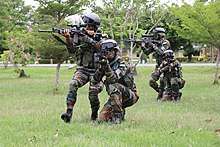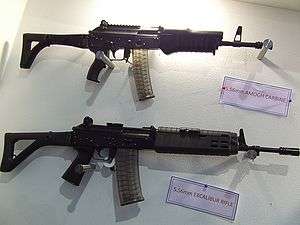INSAS rifle
INSAS (an abbreviation of INdian Small Arms System)[8] is a family of infantry arms consisting of an assault rifle and a light machine gun (LMG). It is manufactured by the Ordnance Factories Board at Ordnance Factory Tiruchirappalli,[9] Small Arms Factory Kanpur[10] and Ishapore Arsenal.[11] The INSAS assault rifle is the standard infantry weapon of the Indian Armed Forces.[1][12][13]
| INSAS Rifle | |
|---|---|
 INSAS rifle in a black finish. | |
| Type | Assault rifle |
| Place of origin | India |
| Service history | |
| In service | 1998–present |
| Used by | See Users |
| Wars | Kargil War[1] Nepalese Civil War[2] Naxalite–Maoist insurgency[3] |
| Production history | |
| Designed | 1980s–1997 |
| Manufacturer | Armament Research and Development Establishment Ordnance Factories Board |
| Produced | 1994[4]–present |
| No. built | 100,000 (Assault Rifles) and 6,000 (LMG) (2012)[5] 700,000–900,000 (2019)[6] |
| Variants | See Variants |
| Specifications | |
| Mass | 4.018 kg (8.86 lb) (without magazine)[7] |
| Length | 960 mm (37.8 in)[7] |
| Barrel length | 464 mm (18.3 in) |
| Cartridge | 5.56×45mm NATO[7] |
| Action | Gas-operated, Rotating bolt |
| Rate of fire | 600–650 rounds/min[7] |
| Muzzle velocity | 900 m/s (2,953 ft/s)[7] |
| Effective firing range | 400m (Insas Rifle) 600 m: Point targets (Insas LMG) 700 m: Area target (Insas LMG)[7] |
| Feed system | 20- or 30-round detachable box magazine |
| Sights | In-built iron sights, mount point for telescopic or night sight |
The rifle will be replaced with AK-203[14] and the frontline units now been equipped with SIG 716s.[15] The light machine gun version is being replaced by the IWI Negev.[16]
History
Since the late 1950s, the Indian armed forces had been equipped with a locally produced copy[17] of the L1A1 self-loading rifles.[12] In mid-1980s, the decision was taken to develop a 5.56 mm calibre rifle to replace other obsolete rifles. Trials on various prototypes based on the AKM were carried out by the Armament Research and Development Establishment (ARDE) in Pune. On the completion of the trial, The Indian Small Arms System (INSAS) was adopted in 1990. However, to phase out the still in use bolt-action Lee–Enfield rifles as quickly as possible, India had to acquire 100,000 7.62×39mm AKM-type rifles from Russia, Hungary, Romania and Israel in 1990–92.[18]
Originally, three variants were planned in the INSAS system, a rifle, a carbine and a squad automatic weapon (SAW) or Light machine gun (LMG). In 1997, the rifle and the LMG went into mass production.[12] In 1998, the first INSAS rifles were displayed at the republic day parade.[1] The introduction of the rifle was delayed due to the lack of 5.56×45mm ammunition, large quantities of the same were bought from Israel Military Industries.[12]
The first combat use of the rifle was during the Kargil War in 1999.[1][12]
The Indian Army is going to be armed partially with the INSAS IC assault rifle.[19]
Design
The INSAS is primarily based on the AKM but incorporates features from other rifles. It has a chrome-plated bore. The barrel has a six-groove rifling. The basic gas operated long stroke piston and the rotating bolt are similar to the AKM/AK-47.[12]


It has a manual gas regulator, similar to that of FN FAL, and a gas cutoff for launching grenades. The charging handle is on the left instead of on the bolt carrier, similar in operation to the HK33.[12] There is a change lever on the left side of the receiver above the pistol grip. It can fire a three-round burst or in semi-automatic mode. The cyclic rate averages at 650 rpm. The transparent plastic magazine was adapted from the Steyr AUG. The rear sight lies on one end of the breech cover and is calibrated to 400 meters. The furniture is either made of wood or polymer.[12] The polymer butt and forend assemblies differ from the AKM and are more similar to that of IMI Galil. Some variants have a folding butt. A bayonet can also be attached to it.[18] The guns take 20- or 30-round polymer magazines. The 30-round magazine is made for the LMG version, but can be also used in the rifle. The flash suppressor also accepts NATO-specification rifle grenades.[12]
Issues
During the 1999 Kargil War, the rifles were used in the high altitudes of the Himalayas. There were complaints of jamming, the magazine cracking due to the cold and the rifle going into automatic mode when it was set for three-round bursts.[1] There was also a problem of oil being sprayed into the eye of the operator. Some injuries during firing practice were also reported.[20] In 2001, the 1B1 variant was introduced to solve problems regarding the rifle's reliability back in the Kargil War, but it opened up other problems such as broken magazines.[21][19]
Similar complaints were also received from the Nepalese Army.[1] In August 2005, after 43 soldiers were killed in a clash with Maoists, a Nepalese Army spokesman called the rifle substandard and their counter-insurgency operation would have been more efficient with better weapons. The Indian embassy released a statement that rejected the claim and attributed it to improper use, it also offered training for the rifle's correct use.[22]
On 8 August 2011, Pallam Raju, then Minister of State for Defence, replying to a question in the Lok Sabha said that all the reported problems had been rectified.[20] Soon afterwards in a press release, the Ministry of Defence reported the number and details of the injuries that had happened during firing practice since 2009. The statement also acknowledged the problem of oil-sprays reported in 2003 and said that the problem had been completely fixed. The report attributed the injuries to improper usage and the rifle's material.[23]
In November 2014, the CRPF requested to drop the INSAS as their standard rifle due to problems with reliability. The Director General of CRPF Dilip Trivedi said that the INSAS jams more frequently compared to the AK-47 and the X-95.[24]
In December 2014, a parliamentary committee presented its report, after investigating why a high-quality assault rifle was not being produced.[25] In 2015, a public interest litigation (PIL) was filed in the Delhi High Court by a retired lieutenant colonel. He claimed that the lack of a modern rifle was causing soldiers to lose their lives. In April 2015, the Court asked the Ministry of Defence to file its response.[26] The Ministry defended the use of the rifle, saying that casualties cannot be blamed on the weapon as it was inducted after thorough trials and had undergone three major upgrades since. They also pointed out the rifle had been not blamed by the Court of Inquires which had investigated the Naxalite operations.[27] In November 2015, the Court dismissed the petition stating that there was not enough evidence to show any defects in the INSAS. It also noted the government was in the process of acquiring new rifles.[28]
In April 2015, the Indian government replaced some INSAS rifles of the CRPF with AK-47s.[29] In early 2017, it was announced that INSAS rifles were to be retired and replaced by rifles capable of firing 7.62×51mm NATO cartridges.[30] In March 2019, media reported that Indian military were set to replace the INSAS with Russia-designed AK-203 assault rifles, manufactured in India under a joint venture.[31]
Variants


INSAS Standard Rifle
It is a gas operated assault rifle. It can be fired in single round or three-round burst mode. A telescopic sight or a passive night sight can be mounted on it. It can take NATO-standard 5.56×45mm SS109 and M193 ammunition. It comes with a bayonet. It has a mount point for the ARDE 40 mm under barrel grenade launcher, along with a gas-block for launching grenades and grenade iron-sights. The flash suppressor has a blank-firing adaptor.[7] It also has a foldable butt version.[32]
An INSAS assault rifle with black furniture, incorporating full-auto mode was introduced later. The automatic assault rifle has the same range of 400 m as the semi-automatic standard INSAS rifle.[33]
LMG
The LMG (Light Machine Gun) differs from the standard rifle in possessing a longer range of 700 m, as compared to 400 m range of INSAS standard and assault rifles. It has a longer and heavier barrel with revised rifling, and a bipod. The LMG version uses 30-round magazines and can also accept the 20-round INSAS AR magazine. This model fires in semi and full-auto.[34] It also has a foldable-butt version.[35]
The LMG will be replaced with the IWI Negev Ng7.[36]
Excalibur
The Excalibur, with a range of 400 m, can be used for battlefield engagements as well as for close combat. It is lighter and shorter as compared to the automatic INSAS assault rifle.[37] In July 2015, it was reported that the INSAS may be replaced by the Modified INSAS rifle (MIR), which is based on the Excalibur variant. The decision was taken by General Dalbir Singh, who wanted an indigenous rifle.[38][39] The prototype had two stoppages after firing 24,000 rounds, which was very close the army's specification of one stoppage. It was also reported that another prototype of Excalibur, AR-2, was being prepared which would fire 7.62×39mm rounds of the AK-47.[38]
The prototype incorporates a direct gas-tapping angle to reduce the recoil. The rifle would have automatic and single shot modes. The three-round burst mode of the INSAS has been dropped. The rifle would have a folding butt and a standard Picatinny rail. By September 2015, it had passed the water and mud tests, which four of the foreign rifles in the tender competition had failed. It was also reported 200 rifles were being manufactured and that prototype would undergo formal trials in late 2015.[40]
Kalantak and Amogh
The Kalantak micro assault rifle, with a range of 300 m, is for close combat and personnel defence weapon roles.[41]
The Amogh carbine, with a range of 200 m, is specially designed for close quarter battle roles.[42]
Operators

- Indian Armed Forces, to be replaced by 750,000 AK-203 rifles and 144,400 SIG-716 Patrol G2 rifles as per the latest contract. [45][46]INSAS LMGs due to be replaced by the IWI Negev NG7 as per latest contract for 16,479 NG7s.[36]
- Indian Paramilitary Forces
- Central Armed Police Forces
- State Police Services
Exports




See also
References
- "INSAS-weary army shops for new infantry arms". The New Indian Express. 16 December 2012. Archived from the original on 29 May 2014. Retrieved 28 May 2014.
- "Wikileaks news: Why Nepal king Gyanendra shed power". The Economic Times. 6 September 2011. Archived from the original on 29 January 2018. Retrieved 29 May 2014.
- "Anti-Naxal operations: CRPF prefers AK rifles to INSAS, bulk purchase on cards". 4 May 2014. Archived from the original on 23 May 2014. Retrieved 29 May 2014.
- Gupta, Jayanta. "End of the line for the Insas rifle". The Times of India. Archived from the original on 5 October 2014. Retrieved 9 May 2019.
- Karp, Aaron; Rajagopalan, Rajesh. Small Arms of the Indian State (PDF). p. 5. Archived (PDF) from the original on 2 January 2019. Retrieved 9 May 2019.
- "Rifle 5.56 mm INSAS (Fixed Butt)". Ordnance Factories Board. Archived from the original on 30 September 2013. Retrieved 29 May 2014.
- "Indian Army prepares to switch to new rifles". India Today. Archived from the original on 18 April 2018. Retrieved 10 May 2018.
- "5.56mm INSAS | ORDNANCE FACTORY TIRUCHIRAPPALLI | Government of India". 24 February 2020. Archived from the original on 24 February 2020.
- "RIFLE 5.56 mm | SMALL ARMS FACTORY | Government of India". 24 February 2020. Archived from the original on 24 February 2020.
- "Rifle Factory Ishapore welcomes you". 18 December 2014. Archived from the original on 18 December 2014.
- Charles Q. Cutshaw (28 February 2011). Tactical Small Arms of the 21st Century: A Complete Guide to Small Arms From Around the World. Gun Digest Books. p. 207. ISBN 1-4402-2482-X. Archived from the original on 8 July 2014. Retrieved 28 May 2014.
- "Manufacturing of Small Weapons". Press Information Bureau. 21 May 2012. Archived from the original on 29 May 2014. Retrieved 29 May 2014.
- Pubby, Manu (9 July 2019). "Joint venture for AK 203 rifles factory at Amethi was the `fastest ever' created with Russia" – via The Economic Times.
- "Indian Army gets new American assault rifles in Kashmir Valley against terrorists, Pakistan Army on LoC". 11 December 2019 – via The Economic Times.
- Gurung, Shaurya Karanbir (19 March 2020). "Defence Ministry signs contract for 16,479 Light Machine Guns for frontline troops with Israel Weapons Industries" – via The Economic Times.
- "UK and Commonwealth FALs, by R. Blake Stevens, Collector Grade Publications, 1980, pages 231-233
- John Walter (25 March 2006). Rifles of the World. Krause Publications. pp. 209–210. ISBN 0-89689-241-7. Archived from the original on 8 July 2014. Retrieved 28 May 2014.
- Frahan, Alain Henry de. "INSAS 1C assault rifle to partially replace predecessor in Indian army - DefExpo 2018 India News Show Daily - Defence security military exhibition 2018 daily news category". www.armyrecognition.com. Archived from the original on 17 May 2018. Retrieved 10 May 2018.
- "INSAS rifles troubled Indian Army men: Raju". Yahoo News. Indo Asian News Service. 8 August 2011. Archived from the original on 29 May 2014. Retrieved 28 May 2014.
- "Hunt on for new generation assault rifles; upgraded INSAS not a replacement". The Economic Times. 31 December 2015. Archived from the original on 30 March 2016. Retrieved 22 February 2016.
- "India rejects claims of Nepalese army on Insas rifle". Outlook India. 13 August 2005. Archived from the original on 29 May 2014. Retrieved 28 May 2014.
- "Accident with Rifles". Press Information Bureau. 8 August 2011. Archived from the original on 4 March 2016. Retrieved 23 February 2016.
- "CRPF asks govt to replace Insas guns with AK rifles". The Times of India. 13 November 2014. Archived from the original on 14 February 2015. Retrieved 1 July 2015.
- "India-made automatic rifle production stuck in red tape". Business Standard. 11 January 2015. Archived from the original on 21 February 2016. Retrieved 22 February 2016.
- "HC Seeks MoD Response on INSAS Rifle PIL". The New Indian Express. 22 April 2015. Archived from the original on 2 March 2016. Retrieved 22 February 2016.
- "PIL dubs INSAS 'defective', govt defends gun". The Times of India. 6 August 2015. Retrieved 22 February 2016.
- "HC dismisses PIL asking to replace INSAS rifles". Business Standard. 3 November 2015. Archived from the original on 2 March 2016. Retrieved 22 February 2016.
- "AK-47s to arm CRPF to teeth". Daily Pioneer. 25 April 2015. Archived from the original on 2 March 2016. Retrieved 23 February 2016.
- "INSAS rifles to retire; to be replaced by imported weapons". The Economic Times. 5 March 2017. Archived from the original on 9 March 2017. Retrieved 16 April 2017.
- "How AK-203, superior to INSAS, will end forces' hunt for a reliable rifle". The Times of India. Archived from the original on 4 March 2019. Retrieved 4 March 2019.
- "5.56 mm INSAS Rifle (Foldable Butt)". Ordnance Factories Board. Archived from the original on 30 September 2013. Retrieved 29 May 2014.
- "5.56 mm Assault Rifle (Fixed Butt)". Ordnance Factories Board. Archived from the original on 4 March 2016. Retrieved 22 February 2016.
- "LMG 5.56 mm INSAS (Fixed Butt)". Ordnance Factories Board. Archived from the original on 30 September 2013. Retrieved 29 May 2014.
- "LMG 5.56 mm INSAS (Foldable Butt)". Ordnance Factories Board. Archived from the original on 30 September 2013. Retrieved 29 May 2014.
- Ruzhelnyk, Olga (24 March 2020). "India orders IWI's Negev 7.62".
- "Rifle Excalibur". Ordnance Factories Board. Archived from the original on 20 April 2016. Retrieved 29 May 2014.
- Unnithan, Sandeep (5 July 2015). "Exclusive: Made in India rifles to replace INSAS". Mail Today. Archived from the original on 5 June 2019. Retrieved 5 June 2019.
- "Indian Army cancels rifle, carbine tenders". Jane's Defence Weekly. 7 July 2015. Archived from the original on 1 September 2015. Retrieved 23 February 2016.
- "Army prepares for crucial trials as chief insists on indigenous Excalibur". Business Standard. 3 September 2015. Archived from the original on 27 February 2016. Retrieved 23 February 2016.
- "Kalantak Micro Assault Rifle". Ordnance Factories Board. Archived from the original on 30 September 2013. Retrieved 29 May 2014.
- "Amogh Carbine". Ordnance Factories Board. Archived from the original on 27 November 2015. Retrieved 20 November 2015.
- ".303 rifles replaced with INSAS: JH police". Business Standard. 11 September 2012. Archived from the original on 29 May 2014. Retrieved 29 May 2014.
- "INSAS rifles to give police more fire power". The Times of India. 15 July 2009. Archived from the original on 31 December 2016. Retrieved 29 May 2014.
- Peri, Dinakar (5 January 2020). "Army to sign MoU for AK-203 assault rifles in a month" – via www.thehindu.com.
- DelhiJuly 12, Manjeet Singh Negi New; July 12, 2020UPDATED:; Ist, 2020 16:51. "Army to place order for 72,000 more Sig716 assault rifles from US". India Today. Retrieved 12 July 2020.CS1 maint: extra punctuation (link) CS1 maint: numeric names: authors list (link)
- Reetika Sharma, Ramvir Goria, Vivek Mishra; Sharma Reetika. India and the Dynamics of World Politics: A book on Indian Foreign Policy, Related events and International Organizations. Pearson Education India. p. 128. ISBN 978-81-317-3291-5. Archived from the original on 8 July 2014. Retrieved 29 May 2014.CS1 maint: multiple names: authors list (link)
- Small Arms Survey (2005). "Reaching for the Big Picture: An Update on Small Arms Transfers" (PDF). Small Arms Survey 2005: Weapons at War. Oxford University Press. p. 101. ISBN 978-0-19-928085-8. Archived from the original on 30 August 2018. Retrieved 29 August 2018.
- https://www.nepalarmy.mil.np/viewnews/438
- "Oman army all set to use India's INSAS rifles". Hindustan Times. 22 April 2010. Archived from the original on 13 March 2014. Retrieved 29 May 2014.
- "Archived copy". Archived from the original on 20 May 2019. Retrieved 18 March 2019.CS1 maint: archived copy as title (link)
External links
| Wikimedia Commons has media related to INSAS rifle. |
